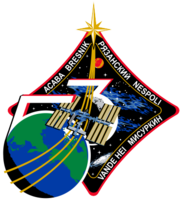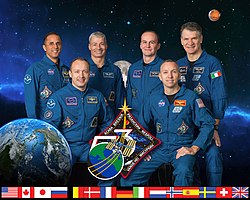ISS-Expedition 53
| Missionsemblem | |||
|---|---|---|---|
 | |||
| Missionsdaten (geplant) | |||
| Mission | ISS-Expedition 53 | ||
| Besatzung | 6 | ||
| Rettungsschiffe | Sojus MS-05, Sojus MS-06 | ||
| Raumstation | Internationale Raumstation | ||
| Beginn | 2. September 2017, 21:58 UTC | ||
| Begonnen durch | Abkopplung von Sojus MS-04 | ||
| Ende | 14. Dezember 2017, 05:14 UTC | ||
| Beendet durch | Abkopplung von Sojus MS-05 | ||
| Dauer | 102d 7h 16min | ||
| Anzahl der EVAs | 3 | ||
| Mannschaftsfoto | |||
 v. l. n. r.: Joseph Acaba, Alexander Missurkin, Mark Vande Hei, Sergei Rjasanski, Randolph Bresnik und Paolo Nespoli | |||
| Navigation | |||
| |||
ISS-Expedition 53 ist die Missionsbezeichnung für die 53. Langzeitbesatzung der Internationalen Raumstation (ISS). Die Mission begann mit dem Abkoppeln des Raumschiffs Sojus MS-04 von der ISS am 2. September 2017 und endete mit dem Abkoppeln von Sojus MS-05 am 14. Dezember 2017.
Mannschaft
Übernommen von ISS-Expedition 52:
- Randolph Bresnik (2. Raumflug), Kommandant (USA/NASA, Sojus MS-05)
- Sergei Nikolajewitsch Rjasanski (2. Raumflug), Bordingenieur (Russland/Roskosmos, Sojus MS-05)
- Paolo Nespoli (3. Raumflug), Bordingenieur (Italien/ESA, Sojus MS-05)
Zusätzlich ab 13. September 2017:
- Alexander Alexandrowitsch Missurkin (2. Raumflug), Bordingenieur (Russland/Roskosmos, Sojus MS-06)
- Mark Thomas Vande Hei (1. Raumflug), Bordingenieur (USA/NASA, Sojus MS-06)
- Joseph M. Acaba (3. Raumflug), Bordingenieur (USA/NASA, Sojus MS-06)
Ersatzmannschaft
Seit Expedition 20 wird wegen des permanenten Trainings für die Besatzungen keine offizielle Ersatzmannschaft mehr bekanntgegeben. Inoffiziell gelten die Backup-Crews der beiden Sojus-Zubringerraumschiffe MS-05 und MS-06 (siehe dort) als Ersatzmannschaft der Expedition 53. In der Regel kommen diese Crews dann jeweils zwei Missionen später selbst zum Einsatz.
Missionsbeschreibung
Crewaustausch
Am 13. September 2017 – gut zehn Tage nach Expeditionsbeginn – koppelte das Zubringerraumschiff Sojus MS-06 nach etwa sechsstündigen Flug an die ISS an; die Besatzung der Raumstation wurde damit wieder auf sechs Personen aufgestockt.
Am Tag vor dem Abdocken von Sojus MS-05 mit Randolph Bresnik, Sergei Rjasanski und Paolo Nespoli übernahm Alexander Missurkin das ISS-Kommando.[1] Zusammen mit Mark Vande Hei und Joseph Acaba bildete er die anfängliche Crew der nachfolgenden ISS-Expedition 54.
Frachterverkehr
Am 17. September wurde Dragon CRS-12 von Paolo Nespoli und Randolph Bresnik mithilfe des Canadarm2-Roboterarms vom Harmony-Modul gelöst und in einer eigenen Umlaufbahn ausgesetzt. Die Wasserung im Pazifik erfolgte noch am selben Tag.
Am 16. Oktober um 11:04 UTC koppelte Progress MS-07 an das Pirs-Modul an. Der Frachter soll acht Monate mit der ISS verbunden bleiben, ehe er im Juni 2018 mit Abfall beladen abgekoppelt und über den Südpazifik zum Verglühen wird.
Am 14. November nutzten Randolph Bresnik und Paolo Nespoli den Greifarm Canadarm2 und fingen das Frachtraumschiff Cygnus OA-8 (genannt „S.S. Gene Cernan“) ein. Durch Kommandos der Bodenstation wurde Cygnus gedreht und an der Unterseite des Moduls Unity angekoppelt.
Cygnus CRS OA-8 (genannt „S.S. Gene Cernan“) wurde am 6. Dezember von der ISS abgekoppelt.
Außenbordarbeiten
Am 5. Oktober ersetzten Randy Bresnik und Mark Vande Hei im Rahmen einer EVA einen von zwei Latching End Effectors (LEE) am Greifarm Canadarm2.
Am 10. Oktober unternahmen Randy Bresnik und Mark Vande Hei einen zweiten Außeneinsatz. Sie brachten ihre Arbeiten am neuen Latching End Effectors (LEE) fertig und ersetzten Kameras am Destiny-Modul.
Am 20. Oktober führten Randy Bresnik und Joseph Acaba den dritten Außeneinsatz durch. Es erfolgte der Austausch einer defekten Kamera am Canadarm2, der Austausch einer Sicherung am Dextre, die Installation einer HD-Kamera an der EHDCA sowie Vorbereitung von potentiell benötigten Ersatzteilen.
Siehe auch
- Liste unbemannter Missionen zur Internationalen Raumstation
- Liste der Raumfahrer
- Liste der Weltraumausstiege
Weblinks
- ISS-Expedition 53 auf den Seiten der NASA (englisch)
- ISS-Expedition 53 bei Spacefacts.de
Einzelnachweise
- ↑ ISS Expedition 53/54 Change of Command Ceremony (Bresnik hands over ISS command to Misurkin). nasa.gov, abgerufen am 30. September 2019.
Auf dieser Seite verwendete Medien
The Expedition 53 crew insignia
- The International Space Station is our launch pad into the future of human space exploration. Collectively, our world stands at the cusp of incredible developments as a spacefaring species. Onboard the space station we continue to evolve the technologies vital to the sustainment and longevity of humans in the harsh realities of living without gravity or the protection of our atmosphere. These self-sustaining or regenerative technologies continually developed aboard the space station not only improve life here on Earth, but they are essential to human beings existence beyond low-Earth orbit (LEO).
- The space station is the linchpin for this next great phase of development and is instrumental in expanding the use of space, not only as a worldclass science laboratory, but also as a destination for next-generation space vehicles. This journey beyond LEO is depicted in the Expedition 53 patch as we, the crew, will endeavor to accomplish the work that allows future missions to further explore our solar system. This journey will only be accomplished as an international team, represented by our multinational crew as well as by the many countries depicted on the globe.
- The myriad of stars represent the untold number of passionate and supremely dedicated people that endeavor across the planet daily to make the space station the amazing vehicle it is as well as prepare us for the next great steps forward in space exploration.
Cygnus Cargo Spacecraft Installed on ISS for Critical Supplies Delivery, November 14, 2017.
- The Cygnus spacecraft is pictured after it had been grappled with the Canadarm2 robotic arm by astronauts Paolo Nespoli and Randy Bresnik on Nov. 14, 2017.
Dragon sunrise! Beautiful scene as the @csa_asc robot arm moves the @SpaceX #Dragon towards the @Space_Station underside berthing port.
The six-member Expedition 53 crew poses for an official crew portrait at the Johnson Space Center in Houston, Texas. Seated in the front (from left) are Flight Engineer Alexander Misurkin of Roscosmos and Commander Randy Bresnik of NASA. Standing in the back (from left) are NASA astronauts Joe Acaba and Mark Vande Hei, Sergey Ryazanskiy of Roscosmos and Paolo Nespoli of the European Space Agency.
Flight Engineer and astronaut Joe Acaba is attached to a portable foot restraint and tethered to the International Space Station's truss structure. Acaba was performing maintenance on the Canadarm2 robotic arm during the third of a series of spacewalks that took place during Expedition 53.









